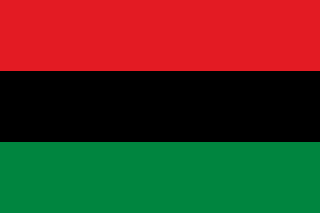Libertarian socialism is an anti-authoritarian and anti-capitalist political current that emphasises self-governance and workers' self-management. It is contrasted from other forms of socialism by its rejection of state ownership and from other forms of libertarianism by its rejection of private property. Broadly defined, it includes schools of both anarchism and Marxism, as well as other tendencies that oppose the state and capitalism.

Syndicalism is a revolutionary current within the labour movement that, through industrial unionism, seeks to unionize workers according to industry and advance their demands through strikes and other forms of direct action, with the eventual goal of gaining control over the means of production and the economy at large through social ownership.
Anarcho-syndicalism is an anarchist organisational model that centres trade unions as a vehicle for class conflict. Drawing from the theory of libertarian socialism and the practice of syndicalism, anarcho-syndicalism sees trade unions as both a means to achieve immediate improvements to working conditions and to build towards a social revolution in the form of a general strike, with the ultimate aim of abolishing the state and capitalism. Anarcho-syndicalists consider trade unions to be the prefiguration of a post-capitalist society and seek to use them in order to establish workers' control of production and distribution. An anti-political ideology, anarcho-syndicalism rejects political parties and participation in parliamentary politics, considering them to be a corrupting influence on the labour movement. In order to achieve their material and economic goals, anarcho-syndicalists instead practice direct action in the form of strike actions, boycotts and sabotage. Anarcho-syndicalists also attempt to build solidarity among the working class, in order to unite workers against the exploitation of labour and build workers' self-management.
The International Workers' Association – Asociación Internacional de los Trabajadores (IWA–AIT) is an international federation of anarcho-syndicalist labor unions and initiatives.

The General Confederation of Labour is a Spanish trade union federation. Formed as a faction of the National Confederation of Labour (CNT) during the Spanish transition to democracy, its support for participation in union elections led it to split from the organisation, which prohibited participation. After losing a lengthy legal battle for the name, the pro-electoral faction renamed itself to the CGT and reorganised itself as an independent trade union center.
According to different scholars, the history of anarchism either goes back to ancient and prehistoric ideologies and social structures, or begins in the 19th century as a formal movement. As scholars and anarchist philosophers have held a range of views on what anarchism means, it is difficult to outline its history unambiguously. Some feel anarchism is a distinct, well-defined movement stemming from 19th-century class conflict, while others identify anarchist traits long before the earliest civilisations existed.

The Zabalaza Anarchist Communist Front, formerly known as the Zabalaza Anarchist Communist Federation (ZabFed), is a platformist–especifista anarchist political organisation in South Africa, based primarily in Johannesburg. The word zabalaza means "struggle" or "active rebellion" in isiZulu, isiXhosa, siSwati and isiNdebele. Initially, as ZabFed, it was a federation of pre-existing collectives, mainly in Soweto and Johannesburg. It is now a unitary organisation based on individual applications for membership, describing itself as a "federation of individuals". Historically the majority of members have been people of colour. Initially the ZACF had sections in both South Africa and Swaziland. The two sections were split in 2007, but the Swazi group faltered in 2008. Currently the ZACF also recruits in Zimbabwe. Members have experienced oppression in South Africa and Swaziland.

Anarchism in Africa refers both to purported anarchic political organisation of some traditional African societies and to modern anarchist movements in Africa.
Anarchism in South Africa dates to the 1880s, and played a major role in the labour and socialist movements from the turn of the twentieth century through to the 1920s. The early South African anarchist movement was strongly syndicalist. The ascendance of Marxism–Leninism following the Russian Revolution, along with state repression, resulted in most of the movement going over to the Comintern line, with the remainder consigned to irrelevance. There were slight traces of anarchist or revolutionary syndicalist influence in some of the independent left-wing groups which resisted the apartheid government from the 1970s onward, but anarchism and revolutionary syndicalism as a distinct movement only began re-emerging in South Africa in the early 1990s. It remains a minority current in South African politics.

Vsevolod Mikhailovich Eikhenbaum, commonly known by his pseudonym Volin, was a Russian anarchist intellectual. He became involved in revolutionary socialist politics during the 1905 Russian Revolution, for which he was forced into exile, where he gravitated towards anarcho-syndicalism.

The Italian Syndicalist Union is an Italian anarcho-syndicalist trade union. Established in 1912 by a confederation of "houses of labour", the USI led a series of general strikes throughout its early years, culminating with the Red Week insurrection against the Italian entry into World War I. During the Biennio Rosso, the USI was at the forefront of the occupation of factories, which saw hundreds of workplaces throughout the country brought under the control of workers' councils. The USI also led the establishment of the International Workers' Association (IWA), which became the main international organisation of anarcho-syndicalist trade unions.

Anarchism in Ireland has its roots in the stateless organisation of the tuatha in Gaelic Ireland. It first began to emerge from the libertarian socialist tendencies within the Irish republican movement, with anarchist individuals and organisations sprouting out of the resurgent socialist movement during the 1880s, particularly gaining prominence during the time of the Dublin Socialist League.
The Industrial and Commercial Workers' Union (ICU) was a trade union and mass-based popular political movement in southern Africa. It was influenced by the syndicalist politics of the Industrial Workers of the World, as well as by Garveyism, Christianity, communism, and liberalism.
The International Socialist League of South Africa was the earliest major Marxist party in South Africa, and a predecessor of the South African Communist Party. The ISL was founded around the syndicalist politics of the Industrial Workers of the World and Daniel De Leon.
Lucien van der Walt is a South African writer, professor of Sociology and labour educator. His research engages the anarchist/syndicalist tradition of Mikhail Bakunin and Peter Kropotkin; trade unionism and working class history, particularly in southern Africa; and neoliberal state restructuring. He currently teaches and researches at Rhodes University in the Eastern Cape, South Africa, and previously worked at the University of the Witwatersrand. His 2007 PhD on anarchism and syndicalism in South Africa in the early 1900s won both the international prize for the best PhD dissertation from the Labor History journal, and the Council for the Development of Social Science Research in Africa prize for best African PhD thesis.
Synthesis anarchism, also known as united anarchism, is an organisational principle that seeks unity in diversity, aiming to bring together anarchists of different tendencies into a single federation. Developed mainly by the Russian anarchist Volin and the French anarchist Sébastien Faure, synthesis anarchism was designed to appeal to communists, syndicalists and individualists alike. According to synthesis anarchism, an anarchist federation ought to be heterogeneous and relatively loosely organised, in order to preserve the individual autonomy of its members.
A general strike is a strike action in which participants cease all economic activity, such as working, to strengthen the bargaining position of a trade union or achieve a common social or political goal. They are organised by large coalitions of political, social, and labour organizations and may also include rallies, marches, boycotts, civil disobedience, non-payment of taxes, and other forms of direct or indirect action. Additionally, general strikes might exclude care workers, such as teachers, doctors, and nurses.
Insurrectionary anarchism is a revolutionary theory and tendency within the anarchist movement that emphasizes insurrection as a revolutionary practice. It is critical of formal organizations such as labor unions and federations that are based on a political program and periodic congresses. Instead, insurrectionary anarchists advocate informal organization and small affinity group based organization. Insurrectionary anarchists put value in attack, permanent class conflict and a refusal to negotiate or compromise with class enemies.
Anarchism in Bulgaria first appeared in the 1860s, within the national movement seeking independence from the Ottoman Empire, strongly influenced by the Russian revolutionary movement. Anarchism established itself as a distinct political movement at the end of the 19th century. It developed further in the 20th century, so much so that Bulgaria was one of the few countries in Eastern Europe where the organized anarchist movement enjoyed a real establishment throughout the country, until the seizure of power by the Bulgarian Communist Party. Under the People's Republic of Bulgaria, the anarchist movement survived underground, but was the victim of severe repression. From 1989, anarchism has been freely reconstituted.
The history of anarcho-syndicalism dates back to the anti-authoritarian faction of the International Workingmen's Association. Revolutionary syndicalism as a tendency was constituted in the 1890s by the French General Confederation of Labour (CGT), which became a model union for other syndicalist organisations to base themselves on. Anarchists were involved in the syndicalist movement from the outset and a specific anarchist tendency developed within the movement over the subsequent decades.








